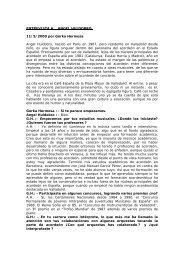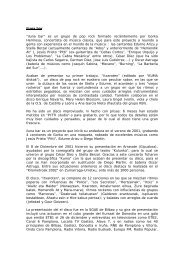The Accordion in the 19th Century - Gorka Hermosa
The Accordion in the 19th Century - Gorka Hermosa
The Accordion in the 19th Century - Gorka Hermosa
Create successful ePaper yourself
Turn your PDF publications into a flip-book with our unique Google optimized e-Paper software.
klut or dd<strong>in</strong>g-pi. <strong>The</strong> first free reed <strong>in</strong>struments with more than one pipe are known as<br />
naw 14 , but <strong>the</strong> best known mouth organ is <strong>the</strong> Ch<strong>in</strong>ese tcheng (which means “sublime<br />
voice”), dated between 3000 and 1100 BC 15 . Very frequently, <strong>the</strong> word tcheng is used<br />
to refer to <strong>the</strong> whole family of mouth organs. Nowadays it is virtually ext<strong>in</strong>ct <strong>in</strong> Ch<strong>in</strong>a<br />
and Korea 16 , but <strong>in</strong> Japan 17 , where it is called sho, it is still played <strong>in</strong> musical<br />
organizations named gagaku. <strong>The</strong>re are more evolved mouth organs such as <strong>the</strong> khene<br />
from Laos or <strong>the</strong> gaeng 18 from Miao. [46, 61, 62, 70, 169, 171, 194, 202, 262, 351]<br />
Fig. 7: Dd<strong>in</strong>g-pi. Fig. 8: Naw. Fig. 9: Tcheng. Fig. 10: Khene. Fig. 11: Gaeng 19 .<br />
14<br />
Depend<strong>in</strong>g on <strong>the</strong> geographical region it is also known with <strong>the</strong> follow<strong>in</strong>g names: la-yu, layübai, fulü, balileao, phloy, phlouy,<br />
d<strong>in</strong>g-nam, köm-boat, mboat, nboat, enkerulai, kledi, engkruri, keluri, Engkruri, garude, sompoton, sumpotan, kaluri, kaleeri,<br />
kaludi...<br />
15<br />
Here we have different <strong>the</strong>ories on <strong>the</strong> tcheng dat<strong>in</strong>g: [70,108, 194, 203, 262]<br />
- Accord<strong>in</strong>g to Monichon, [202], oral tradition says that it was about 2700 BC. dur<strong>in</strong>g <strong>the</strong> rule of emperor Hang-Si.<br />
- Accord<strong>in</strong>g to Curt Sachs [119, 240, 361], it was <strong>in</strong> <strong>the</strong> third millennium BC, dur<strong>in</strong>g <strong>the</strong> rule of empress Nya-Kwa, <strong>the</strong><br />
successor of Fu Hsi (<strong>the</strong> <strong>in</strong>ventor of music, accord<strong>in</strong>g to <strong>the</strong> same tradition). <strong>The</strong> first written document <strong>in</strong> which <strong>the</strong><br />
tcheng appears is an ode book dat<strong>in</strong>g from Y<strong>in</strong> dynasty (between 11 th c. an 12 th c. BC <strong>in</strong> which <strong>the</strong> tcheng appears with<br />
<strong>the</strong> names od ho and shih-ch<strong>in</strong>g), but accord<strong>in</strong>g to Miller, Sachs does not provide any bibliography to support that fact.<br />
Accord<strong>in</strong>g to Sachs, <strong>the</strong> first illustration dates back from 551 BC and it is exhibited <strong>in</strong> Philadelphia`s University<br />
Museum.<br />
- Accord<strong>in</strong>g to <strong>the</strong> book Ch<strong>in</strong>ese Music by Van Aalst [261], Nü-wo was <strong>the</strong> artificer of <strong>the</strong> tcheng.<br />
- Accord<strong>in</strong>g to Pat Miss<strong>in</strong> [199], <strong>the</strong> tradition recognizes <strong>the</strong> <strong>in</strong>vention to semi-mythical characters such as emperor Huan<br />
Di (also transcribed as Huang Ti) or empress Nu Gua (also transcribed as Nu Kua, Nu Qua, Nu Koua, Nawa...) <strong>in</strong> <strong>the</strong><br />
third millennium BC. Its shape seems to be <strong>in</strong>spired by <strong>the</strong> sitt<strong>in</strong>g Phoenix (<strong>in</strong> <strong>the</strong> same way as <strong>the</strong> Ch<strong>in</strong>ese pan flute<br />
symbolizes <strong>the</strong> fly<strong>in</strong>g Phoenix). <strong>The</strong> first written descriptions go back to <strong>the</strong> 15 th c. BC. and <strong>the</strong>y use <strong>the</strong> name he,<br />
although later <strong>the</strong> name tcheng has been generalized to refer <strong>the</strong> whole family of <strong>the</strong>se <strong>in</strong>struments.<br />
- Accord<strong>in</strong>g to Frans Van der Grijn [262], <strong>the</strong> first reference to <strong>the</strong> tcheng was circa 1100 BC., period <strong>in</strong> which Ord-Hume<br />
put forward that <strong>the</strong>re were legends suggest<strong>in</strong>g that <strong>the</strong> <strong>in</strong>strument had been <strong>in</strong>vented by <strong>the</strong> Ch<strong>in</strong>ese emperor Huang Tei<br />
2852 years BC or by Huang Tei 2500 years BC. <strong>The</strong> first known illustration of <strong>the</strong> tcheng is a stele (stone altar or<br />
sacrificial table) from 51 AD displayed <strong>in</strong> <strong>the</strong> Museum of Archeology & Anthropology at University of Pennsylvania.<br />
- Accord<strong>in</strong>g to Miller [194], <strong>the</strong> first written reference is <strong>in</strong> <strong>the</strong> Shih Ch<strong>in</strong>g (typical Ch<strong>in</strong>ese song book written between<br />
10 th and 7 th c. BC.) <strong>in</strong> which <strong>the</strong> tcheng appears numerous times. Miller reports that Aurel Ste<strong>in</strong> published <strong>in</strong> <strong>The</strong><br />
Thousand Buddhas (Bernard Quaritch Ltd, London 1921) reproductions of pa<strong>in</strong>t<strong>in</strong>gs dated between 850 and 900 BC.<br />
found <strong>in</strong> cave-shr<strong>in</strong>es <strong>in</strong> Tun-huang (Ch<strong>in</strong>a) that show groups of musicians, among which some are play<strong>in</strong>g <strong>the</strong> tcheng.<br />
- <strong>The</strong>re are some documents that give evidence that <strong>the</strong> tcheng was played at <strong>the</strong> funeral of Confucius (551-479 BC), <strong>the</strong><br />
most important Eastern philosopher <strong>in</strong> antiquity, and by that time, it was an <strong>in</strong>strument used for religious rituals. <strong>The</strong>re<br />
are sources that describe even Confucius himself as a tcheng player. [194]<br />
16 th<br />
Accord<strong>in</strong>g to Picken, <strong>the</strong> tcheng arrived <strong>in</strong> Korea <strong>in</strong> <strong>the</strong> 5 c., where it took <strong>the</strong> name of saign or saeng-hwang. [194]<br />
17<br />
Sachs states that <strong>the</strong> tcheng arrived <strong>in</strong> Japan about 1000 BC., but o<strong>the</strong>r sources (Reischauer, Fairbanko Picken) hold that it arrived<br />
<strong>in</strong> Japan around <strong>the</strong> 6 th or 7 th c. AD. [194]<br />
18<br />
It is also known as daeng, ki, liu sheng... [194]<br />
19<br />
Figs. 17, 18, 19, 20 and 21 taken from: Miller [194] pages 70, 72, 74, 91, 87 and 84 respectively.<br />
12




